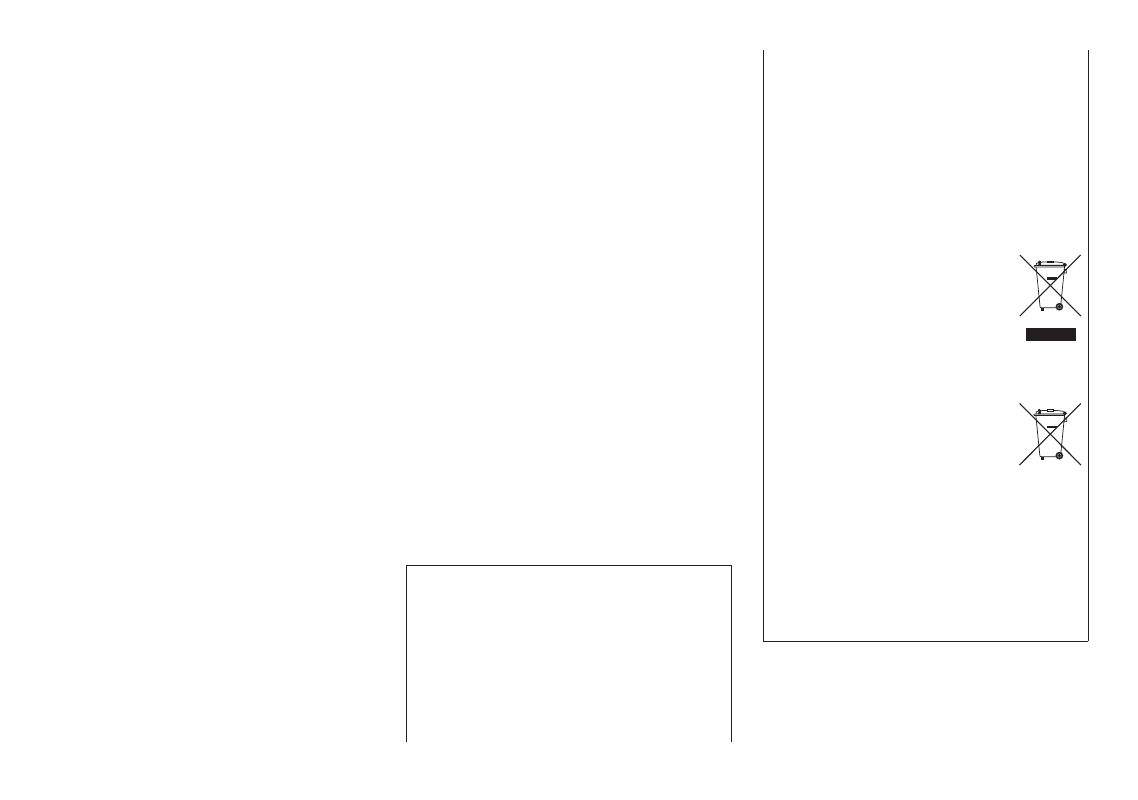Caution, Cautions about batteries, For european customers – Tascam Portacapture X6 32-Bit 6-Channel Multitrack Field Recorder User Manual
Page 4

CAUTION
• Do not expose this apparatus to drips or splashes.
• Do not place any objects filled with liquids, such as
vases, on the apparatus.
• Do not install this apparatus in a confined space such as
a book case or similar unit.
• If the product uses batteries (including a battery pack
or installed batteries), they should not be exposed to
sunshine, fire or excessive heat.
• CAUTION for products that use replaceable lithium
batteries: there is danger of explosion if a battery is
replaced with an incorrect type of battery. Replace only
with the same or equivalent type.
• Installed battery subjected to extremely low air
pressure may result in an explosion or the leakage of
flammable liquid or gas.
CAUTIONS ABOUT BATTERIES
This product uses batteries. Misuse of batteries could
cause a leak, rupture or other trouble. Always abide by the
following precautions when using batteries.
• Never recharge non-rechargeable batteries. The
batteries could rupture or leak, causing fire or injury.
• When installing batteries, pay attention to the polarity
indications (plus/minus (
¥
/
^
) orientation), and
install them correctly in the battery compartment as
indicated. Putting them in backward could make the
batteries rupture or leak, causing fire, injury or stains
around them.
• When you store or dispose batteries, isolate their
terminals with insulation tape or something like that
to prevent them from contacting other batteries or
metallic objects.
• When throwing used batteries away, follow the disposal
instructions indicated on the batteries and the local
disposal laws.
• Do not use batteries other than those specified. Do not
mix and use new and old batteries or different types of
batteries together. The batteries could rupture or leak,
causing fire, injury or stains around them.
• Do not carry or store batteries together with small
metal objects. The batteries could short, causing leak,
rupture or other trouble.
• Do not heat or disassemble batteries. Do not put them
in fire or water. Batteries could rupture or leak, causing
fire, injury or stains around them.
• If the battery fluid leaks, wipe away any fluid on
the battery case before inserting new batteries. If
the battery fluid gets in an eye, it could cause loss
of eyesight. If fluid does enter an eye, wash it out
thoroughly with clean water without rubbing the eye
and then consult a doctor immediately. If the fluid
gets on a person’s body or clothing, it could cause skin
injuries or burns. If this should happen, wash it off with
clean water and then consult a doctor immediately.
• The unit power should be off when you install and
replace batteries.
• Remove the batteries if you do not plan to use the unit
for a long time. Batteries could rupture or leak, causing
fire, injury or stains around them. If the battery fluid
leaks, wipe away any fluid on the battery compartment
before inserting new batteries.
• Do not disassemble a battery. The acid inside the
battery could harm skin or clothing.
For European Customers
Disposal of electrical and electronic
equipment and batteries and/or accumulators
(a) All electrical/electronic equipment and waste
batteries/accumulators should be disposed of
separately from the municipal waste stream via
collection facilities designated by the government
or local authorities.
(b) By disposing of electrical/electronic equipment
and waste batteries/accumulators correctly, you
will help save valuable resources and prevent any
potential negative effects on human health and the
environment.
(c) Improper disposal of waste electrical/electronic
equipment and batteries/accumulators can have
serious effects on the environment and human
health because of the presence of hazardous
substances in the equipment.
(d) The Waste Electrical and Electronic
Equipment (WEEE) symbols, which
show wheeled bins that have been
crossed out, indicate that electrical/
electronic equipment and batteries/
accumulators must be collected
and disposed of separately from
household waste.
If a battery or accumulator contains
more than the specified values of lead
(Pb), mercury (Hg), and/or cadmium
(Cd) as defined in the Battery Directive
(2006/66/EC, 2013/56/EU), then the
chemical symbols for those elements
will be indicated beneath the WEEE
symbol.
Pb, Hg, Cd
(e) Return and collection systems are available to end
users. For more detailed information about the
disposal of old electrical/electronic equipment and
waste batteries/ accumulators, please contact your
city office, waste disposal service or the shop where
you purchased the equipment.
4
TASCAM Portacapture X6